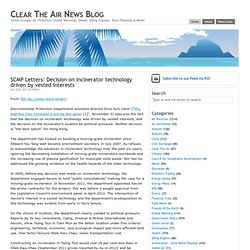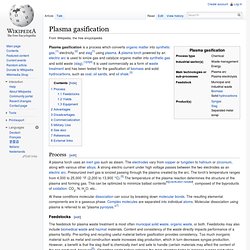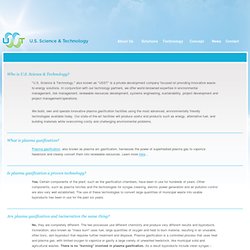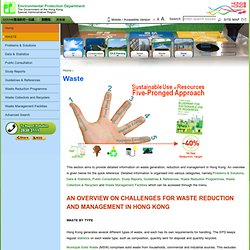

50 MW Plasma Gasification Facility to Treat Waste in Tees Valley. SCGI: Top 10 Facts about the Plasma Gasification of Municipal Solid Wastes – Clear The Air News Blog. SCMP Letters: Decision on incinerator technology driven by vested interests – Clear The Air News Blog. From Tom Yau, Lantau Island resident: Environmental Protection Department assistant director Elvis Au’s claim (“Why Shek Kwu Chau incinerator is still the best option [1]“, November 5) obscures the fact that the decision on incinerator technology was driven by vested interests, and the decision on the incinerator’s location by political pressure.

Neither decision is “the best option” for Hong Kong. The department has fixated on building a moving-grate incinerator since Edward Yau Tang-wah became environment secretary in July 2007. Au refuses to acknowledge the advances in incinerator technology over the past six years, ignoring the decreasing installation of moving-grate incinerators worldwide and the increasing use of plasma gasification for municipal solid waste. What kind of waste incinerator does Hong Kong need? The troubling question of what to do about Hong Kong's waste got a spirited airing at a public forum yesterday evening.

There was a panel of five experts who were attending the "International Conference on Solid Waste 2013 - Innovation in Technology and Management". The conference was organised by the Sino-Forest Applied Research Centre for Pearl River Delta Environment, which is attached to Hong Kong Baptist University. The previous administration's proposal was to build a large 3,000-tonnes-per-day incinerator on the controversial location of Shek Kwu Chau, a scenic island off South Lantau. Legco shelved this last year. There has also been controversy over the type of technology to be used, with critics saying the government has not properly looked at other forms of technology such as gasification. All this aside, it seems clear that modern incinerators have drastically reduced emissions over the past 15 years. 50 MW Plasma Gasification Plant to be the First of Many in UK. Plasma gasification. Process[edit] A plasma torch uses an inert gas such as steam.

The electrodes vary from copper or tungsten to hafnium or zirconium, along with various other alloys. A strong electric current under high voltage passes between the two electrodes as an electric arc. Pressurized inert gas is ionized passing through the plasma created by the arc. The torch's temperature ranges from 4,000 to 25,000 °F (2,200 to 13,900 °C).[5] The temperature of the plasma reaction determines the structure of the plasma and forming gas. Feedstocks[edit] The feedstock for plasma waste treatment is most often municipal solid waste, organic waste, or both. Yields[edit] Pure highly calorific synthetic gas consists of Carbon monoxide (CO), H2, CH, etc.. Plasma processing of waste is ecologically clean. The production of ecologically clean synthetic gas is the standard goal. Metals resulting from plasma pyrolysis can be recovered from the slag and eventually sold as a commodity.
Equipment[edit] Advantages[edit] Www.legco.gov.hk/yr12-13/english/panels/ea/papers/eacb1-1474-3-e.pdf. Www.savedanford.com/pdfs/press/a011/en/Appendix04.pdf. USST. Who is U.S.

Science & Technology? "U.S. Science & Technology," also known as "USST" is a private development company focused on providing innovative waste-to-energy solutions. In conjunction with our technology partners, we offer world-renowned expertise in environmental management, risk management, renewable resources development, systems engineering, sustainability, project development and project management/operations. We build, own and operate innovative plasma gasification facilities using the most advanced, environmentally friendly technologies available today. What is plasma gasification? Plasma gasification, also known as plasma arc gasification, harnesses the power of superheated plasma gas to vaporize feedstock and cleanly convert them into renewable resources.
Is plasma gasification a proven technology? Yes. Are plasma gasification and incineration the same thing? No, they are completely different. Where is similar technology being used? No. What about air quality? Environmental Protection Department. This section aims to provide detailed information on waste generation, reduction and management in Hong Kong.

An overview is given below for the quick reference. Detailed information is organised into various categories, namely,Problems & Solutions, Data & Statistics, Public Consultation, Study Reports, Guidelines & References, Waste Reduction Programmes, Waste Collectors & Recyclers and Waste Management Facilities which can be accessed through the menu. WASTE BY TYPE Hong Kong generates several different types of waste, and each has its own requirements for handling. The EPD keeps regular statistics on each waste type, such as composition, quantity sent for disposal and quantity recycled. Municipal Solid Waste (MSW) comprises solid waste from households, commercial and industrial sources.
Plasma gasification: Clean renewable fuel through vaporization of waste. Www.legco.gov.hk/yr12-13/english/panels/ea/papers/eacb1-1474-3-e.pdf.